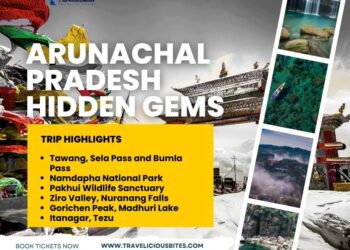The Spirit of Adventure: Changla Pass in Ladakh
There’s a unique sense of awe that sweeps over every traveler as they approach the mighty Himalayas. Among the region’s many legendary routes, few are as iconic or exhilarating as Changla Pass in Ladakh. After a few winding turns and steep climbs, you’ll find yourself at an altitude where the sky feels closer, the air is crisp, and the landscape is painted in surreal shades of white and brown.
If you’re planning a trip to Ladakh, conquering Changla Pass is a rite of passage. This high-altitude marvel is not just a road—it’s a journey through some of the most dramatic and untouched scenery on the planet. Whether you’re a biker, road trip enthusiast, or a nature lover, the experience of crossing Changla Pass in Ladakh will stay with you forever.
What Makes Changla Pass Legendary?
Altitude & Location:
Changla Pass sits at a staggering 5,360 meters (17,590 feet) above sea level, making it the third highest motorable mountain pass in the world. It connects Leh to the Shyok River valley and is the main gateway to the famous Pangong Lake and the Changthang plateau.
Route & Accessibility:
The pass is approached from Leh via Kharu and Sakti villages, with a steep ascent that requires careful driving. The climb is challenging, especially for bikers, as the road can turn to slush and loose dirt, particularly after winter or during the summer melt. Streams often cross the route, adding to the adventure.
Scenic Beauty:
The views from Changla Pass are nothing short of magical. Snow-capped peaks, endless barren landscapes, and undulating valleys stretch as far as the eye can see. On clear days, the panorama is simply breathtaking.
Cultural Touches:
At the top, you’ll find a small temple dedicated to Changla Baba, prayer flags fluttering in the wind, and a tea point where the Indian Army offers hot tea to travelers—a welcome treat in the chilly air.
Gateway to Pangong Lake:
Changla Pass is the crucial link on the Leh–Pangong Lake route, making it a must-cross for anyone heading to one of Ladakh’s most iconic lakes.
Essential Tips for Crossing Changla Pass
Acclimatize:
Spend a day or two in Leh before attempting the pass to avoid altitude sickness. Doctors recommend not staying at the top for more than 20-25 minutes due to the high elevation.
Drive Carefully:
The steep ascent and descent, loose dirt, and slush can be tricky. Four-wheel drives and experienced drivers are recommended, especially during the tourist season.
Best Time to Visit:
The pass is open most of the year but is best crossed between May and September when weather conditions are more stable.
Permits:
An Inner Line Permit is required for Indian citizens and Protected Area Permit for foreigners to cross Changla Pass and visit Pangong Lake.
Facilities:
Public conveniences and a tea point are available at the top, but amenities are basic. Carry water, snacks, and warm clothing.
The Adventure Continues: 51+ Amazing Places to Visit in Ladakh!
Ladakh is a land of endless wonders, and Changla Pass is just the beginning. Here’s a curated list of must-visit destinations that will make your trip to Ladakh truly unforgettable:
Iconic Passes & Roads
Khardung La Pass: The world’s highest motorable road.
Taglang La Pass: Another high-altitude marvel on the Leh-Manali highway.
Magnetic Hill: Experience the optical illusion of vehicles rolling uphill.
Majestic Lakes
Pangong Lake: Famous for its changing colors and Bollywood fame.
Tso Moriri Lake: A tranquil, lesser-known high-altitude gem.
Tso Kar Lake: A saltwater lake surrounded by wildlife.
Monasteries & Spiritual Sites
Hemis Monastery: The largest and richest monastery in Ladakh.
Thiksey Monastery: Known for its resemblance to the Potala Palace.
Diskit Monastery: Home to a giant Maitreya Buddha statue.
Alchi Monastery: Renowned for its ancient murals and art.
Valleys & Villages
Nubra Valley: Sand dunes, double-humped camels, and lush villages.
Zanskar Valley: Remote, wild, and perfect for trekkers.
Markha Valley: A trekker’s paradise with dramatic landscapes.
Lamayuru: Known as the “Moonland” for its lunar-like terrain.
Adventure & Wildlife
Hemis National Park: Spot elusive snow leopards and Himalayan wildlife.
Chadar Trek: Walk on the frozen Zanskar River in winter.
Yak Safaris: Experience Ladakh’s nomadic culture.
Cultural & Historical Experiences
Leh Palace: A glimpse into Ladakh’s royal past.
Stok Palace: The residence of Ladakh’s former royal family.
Shanti Stupa: A symbol of peace with panoramic Leh views.
Sindhu Ghat: The confluence of the Indus and Zanskar rivers.
Unique Experiences
Camping by Pangong Lake: Sleep under a million stars.
Local Markets in Leh: Shop for Pashmina shawls, handicrafts, and jewelry.
Apricot Orchards in Nubra: Taste Ladakh’s sweetest fruit.
Hot Springs at Panamik: Soak in natural thermal waters.
Planning Your Trip to Ladakh: Practical Advice
Best Time to Visit:
May to September is ideal for most routes, passes, and lakes.
How to Get There:
Fly into Leh or take the scenic road trip from Manali or Srinagar.
Permits:
Arrange permits in advance for restricted areas and high-altitude passes.
Health & Safety:
Acclimatize, stay hydrated, and avoid strenuous activity on the first day.
Packing Essentials:
Warm clothing, sunscreen, sunglasses, and a camera for those epic views.
Why Changla Pass and Ladakh Should Be on Your Bucket List
Crossing Changla Pass in Ladakh is more than just a tick on your itinerary—it’s an adventure that tests your spirit and rewards you with some of the most stunning vistas on earth. From high mountain passes and sapphire lakes to ancient monasteries and vibrant villages, the places to visit in Leh Ladakh promise a blend of thrill, serenity, and timeless beauty.
So, gear up for your trip to Ladakh, conquer Changla Pass, and let the magic of the Himalayas transform you. Every turn, every climb, and every moment in Ladakh is a story waiting to be lived.
Ready for the journey of a lifetime? Ladakh’s mountains are calling—answer with adventure!






